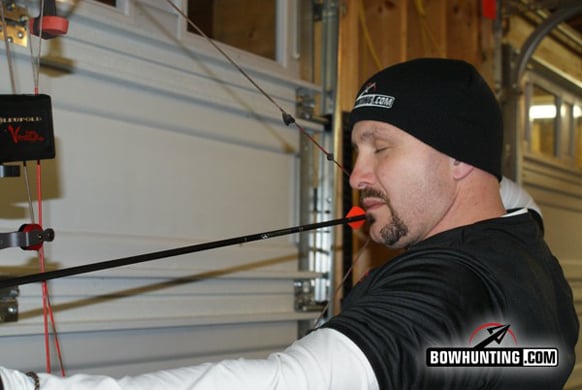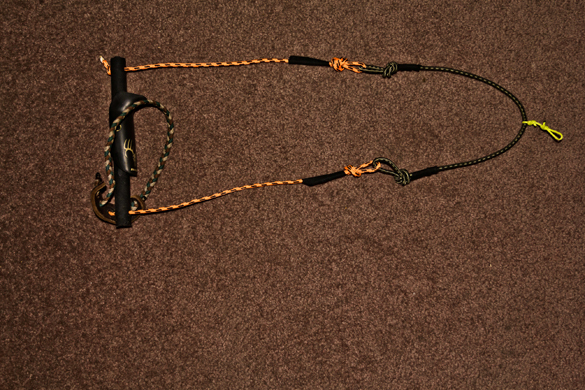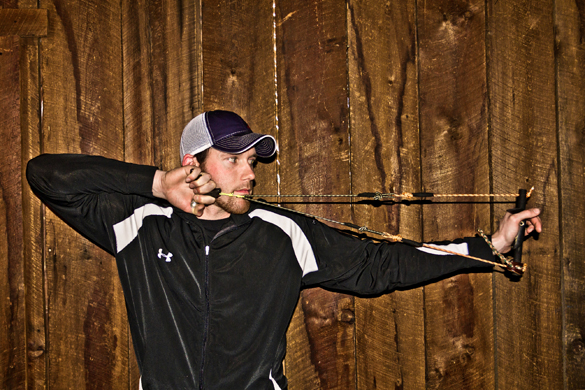LAST UPDATED: May 1st, 2015
Written by Bowhunting.com contributor Brady Miller.
When the last day of the bowhunting season ends…the next one begins; and there is no time like the present to start preparing for the coming season. I know it’s easy to let your shooting regimen slip during the winter months with the frosty weather and the snow piling up outside. Nevertheless, you shouldn’t let that discourage you from working to refine your shot execution during the offseason.
Everyone has their own method for executing their shot. I am not going to go into detail on the various ways you can activate your release which range from trigger squeezers, to punchers, to shooters who subconsciously achieve a surprised release… But, I do want to stress that you should do what works for you and what method produces the most consistent and repeatable results. For me one of the ways to produce the most consistent shot activation is by utilizing a back tension release. My training regimen is achieved using a device that I built myself. You can do the same.
Purpose
Now, you might be asking yourself “why would I need one of these training devices and how will it benefit me as a bowhunter”? In a nut shell, Target Panic is a real deal breaker for many archers and bowhunters alike, and this device is a perfect way to train both your mind and body to execute that perfect “unanticipated” shot. This device works great from the comfort of your own home, on the road traveling in a hotel room, or as a warm up before hitting the field or target range. It is also great for testing out a new release without fear of sending an arrow astray or for teaching beginning archers the proper way to execute their shot.
Wintertime is a great time to work on shooting techniques like “Blind Bale” shooting and many others.
Even more, this will work for any type of release including a caliper release, thumb activated, hinge releases, and even finger shooters. This training device also aids in achieving the feel for the correct muscle groups that are engaged during a release, rather than replicating the weight of your bow. It enables you to truly experience what a good shot feels like for those times when you can’t shoot your bow or just want more practice.
Construction
Making a back tension training aid is quite simple, yet it yields immense results. I developed my back tension trainer from household items and one small trip to the hardware store. In total, this device cost me less than five dollars. For me the trainer consists of a small section of an old ski pole, an old bow grip to simulate the feel of a bow riser, bow sling, d-loop material, parachute cord, and flex cord. But in reality the options are endless as far as what other items you could use to build the training device.
Don’t let the looks fool you. This inexpensive tool has the potiental to make you deadly in the woods this spring and fall.
First, I covered the ski pole in athletic tape to give it some grip. Then I cut the ski pole at roughly nine inches and drilled a hole at the top and bottom (the length of the pole just has to be long enough for your hand and/or bow grip to be placed in the middle, plus room for the parachute cord to be attached at the top and bottom). My suggestion is to keep it short enough for travel reasons.
Next I cut two equal lengths of the parachute cord at roughly 15 inches. I attached the top and bottom pieces by making a knot in the cord so it will not pull through and then melted the ends to prevent fraying. Finally I inserted the cord through the pre-drilled holes. I decided it was more consistent if I added a bow sling so I could focus on shot execution and also practice proper bow hand placement at the same time. Therefore I attached a bow sling to the bottom of the pole.
The beauty of this device is that it can be used almost anywhere and costs next to nothing to build.
For the next step, I added a loop of d-loop material to the middle of the flex cord from which my release could attach, in order to simulate a realistic d-loop. I decided to make a loop that I could micro adjust the length if needed, rather than form the typical d-loop. From this point, I tied the flex cord to the parachute cord and drew the device back and loosened or tightened the cords until I determined the proper tension needed for my specific draw length. The beauty of this design is that the parachute cord will not slap your hand if you make the draw length correct, as it will just have enough tension to engage pressure on the jaw mechanism of your release. And finally I cut the extra length of the flex and parachute cords and burned their ends.
Conclusion
While nothing is quite as effective as blank bale shooting for instilling proper shooting habits, this device will allow you to shoot without distractions or hindrances caused by muscle fatigue from holding and drawing a bow for a long period of time during practice sessions. This back tension device which you can build will assist you in creating that perfect unanticipated release that will help you become a better shot when the moment of truth arrives.








